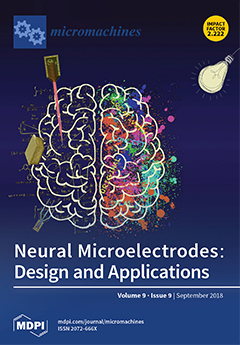Hemorheological properties such as viscosity, deformability, and aggregation have been employed to monitor or screen patients with cardiovascular diseases. To effectively evaluate blood circulating within an in vitro closed circuit, it is important to quantify its hemorheological properties consistently and accurately. A simple
[...] Read more.
Hemorheological properties such as viscosity, deformability, and aggregation have been employed to monitor or screen patients with cardiovascular diseases. To effectively evaluate blood circulating within an in vitro closed circuit, it is important to quantify its hemorheological properties consistently and accurately. A simple method for measuring red blood cell (RBC) aggregation and blood viscosity is proposed for analyzing blood flow in a microfluidic device, especially in a continuous and simultaneous fashion. To measure RBC aggregation, blood flows through three channels: the left wide channel, the narrow channel and the right wide channel sequentially. After quantifying the image intensity of RBCs aggregated in the left channel (<I
RA>) and the RBCs disaggregated in the right channel (<I
RD>), the RBC aggregation index (AI
PM) is obtained by dividing <I
RA> by <I
RD>. Simultaneously, based on a modified parallel flow method, blood viscosity is obtained by detecting the interface between two fluids in the right wide channel. RBC aggregation and blood viscosity were first evaluated under constant and pulsatile blood flows. AI
PM varies significantly with respect to blood flow rate (for both its amplitude and period) and the concentration of the dextran solution used. According to our quantitative comparison between the proposed aggregation index (AI
PM) and the conventional aggregation index (AI
CM), it is found that AI
PM provides consistent results. Finally, the suggested method is employed to obtain the RBC aggregation and blood viscosity of blood circulating within an in vitro fluidic circuit. The experimental results lead to the conclusion that the proposed method can be successfully used to measure RBC aggregation and blood viscosity, especially in a continuous and simultaneous fashion.
Full article






